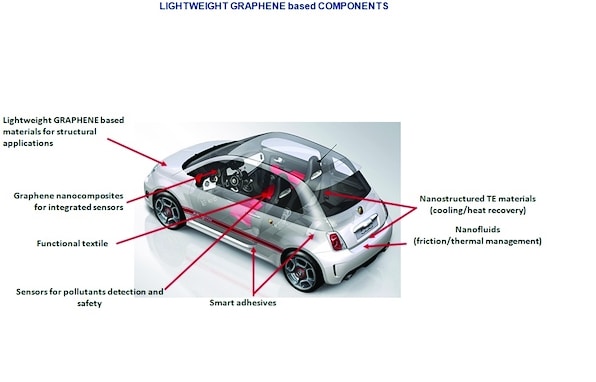This is the claim of Sunderland University’s Prof Ahmed Elmarakbi, who is leading a project with European partners to develop lighter, stronger, and more energy-efficient vehicles using graphene.
Prof Elmarakbi, from Sunderland’s Department of Computing, Engineering and Technology, told The Engineer that the iGCAuto project would achieve this by producing a new type of composite material using a polymer enhanced with graphene.
He said: ‘The idea is to keep the composite material as it is – composed by carbon fibre or glass fibre.
‘We’ll enhance the polymer characterisation by embedding graphene in certain ways inside the polymer – the polymer will be enhanced by being stronger and lighter.’

The automotive industry has been identified as requiring significant volumes of components made from advanced composite materials that can reduce the overall weight of a vehicle and the amount of fuel required to operate it.
However, such light weighting, said Prof Elmarakbi, usually compromises vehicle and occupant safety.
‘Due to the trade-off between light vehicles and safety standards, a new direction of light weighting should be adopted to minimise the collision mitigation and improve crashworthiness,’ he said. ‘Our materials will provide benefits such as improved strength, dimensional stability, superior durability, and enhance energy absorption capabilities, yet remain superlight.’
On top of safety, automotive manufacturers have been challenged to produce vehicles that meet emissions targets that in the EU include reducing CO2 emissions from new cars to 130 grams per kilometre by 2012/15, and by as low as 95 grams by 2020.
Prof Elmarakbi said that for the automotive industry, light weighting could account for a 5-7 per cent increase in fuel economy for every 10 per cent of massreduction.
‘So for example, if we can enable a five per cent mass reduction in the long run - not in the first models - then thiswould lead to 0.0035 litres/km reduction in fuel consumption,’ he added via email. ‘Over a 150,000km car lifetime, thisresults in some 500 litres less, resulting in some 1.2 tons of CO2 reduced per car over the lifetime ofthe car.’
He added that by 2025 around 60 million new cars will be produced globally and that 7.2 millions tons of CO2 emissions could be avoided if light weighting were implemented in 10 per cent of those vehicles.
‘We are targeting to achieve around 30-to-50 per cent of weight reduction for individual automotive components, based on the components, he said. ‘The future of this project is to use the new materials in almost all vehicle components/structures towards 30-50 per cent weight reduction for the entire cars.’
Prof Elmarakbi acknowledged that this is a very optimistic goal but achievable within the remit of the project, which includes the creation of new syntheses and modelling techniques that will be used to simplify the applications of the project’s materials in several applications.
‘Graphene has superior properties and can produce a dramatic improvement in properties at low filler content, however the modelling techniques for graphene based composite materials are still in a very early stage,’ he said.
The 18-month iGCAuto project is scheduled to start this October. Partners include Centro Ricerche FIAT, Italy; Fraunhofer ICT, Germany; Interquimica, Spain; Nanesa S.r.l., Italy; and Delta-Tech S.p.A., Italy.





Nanogenerator consumes CO2 to generate electricity
Nice to see my my views being backed up by no less a figure than Sabine Hossenfelder https://youtu.be/QoJzs4fA4fo